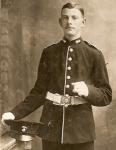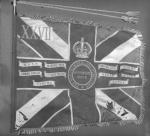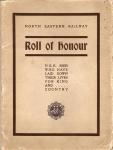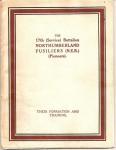-
Posts
1,065 -
Joined
-
Last visited
-
Days Won
1
Content Type
Profiles
Forums
Blogs
Gallery
Events
Store
Everything posted by Graham Stewart
-

Photos Royal Inniskillin Fusiliers
Graham Stewart replied to Noor's topic in Great Britain: Research, Documentation & History
A Lieutenant Colonel, but the collar badge is unfamiliar to me, so suspect he commands an Indian Regiment post-1920. -

Swagger sticks
Graham Stewart replied to paul w's topic in Great Britain: Militaria: Badges, Uniforms & Equipment
Probably a better photo of an old Sgt, 3rd Volunteer Battalion, Northumberland Fusiliers taken at a Volunteer Camp, Ripon, Yorks, showing the type of walking-out cane as illustratated by Paul. -

Swagger sticks
Graham Stewart replied to paul w's topic in Great Britain: Militaria: Badges, Uniforms & Equipment
Typical pose of an an other-rank in walking out dress carrying a walking-out cane, but with a ball top. The photo has a sad story to it, as the lad in question is "3751 Pte Samuel Thomas Hogan" of 24 Hollyhedge Lane, Walsall, Staffs and was taken at Newcastle-upon-Tyne on his completion of Training at the 5/68th Depot in early 1914. He was drafted to the 1st Battalion the same year, with whom he was to die of wounds on the 5th March 1915, aged 21yrs and is now buried in Ramparts Cemetery, Lille Gate, Belgium. -

Swagger sticks
Graham Stewart replied to paul w's topic in Great Britain: Militaria: Badges, Uniforms & Equipment
I believe those examples with the crowns are early ones, possibly c.1900's whereas those without are possibly c.1920's/30's. Although commonly called "swagger sticks" they are actually "walking out canes" and were part of the dress code of other ranks on leaving barracks before the Great War. They were often seen during the Great War in studio portraits, while wearing Service Dress, but their use seems to have petered out among the other ranks post 1930's, as I haven't seen them in photo's being carried any later, but junior NCO's may have still caried them while carrying out specific duties within barracks. Senior NCO's carried a much larger version, a tradition which is still carried on in barracks today, when on certain duties and these too were also embelished with regimental devices.. Officers also carried canes but these teded to be plain with no embelishments and often bound in leather. -
Picked one of these up years ago and yours is infact only the second I've ever seen. The "Queens Fusiliers" as they were, seemed to keep their old pattern RRF/Queens badges for each the RRF/Queens contingents that made up the battalion, with only slip on titles seemingly made to reflect that it was a 'new' unit. I'm unsure if they had a band or what the head-dress was for the band, but unless they wore a blue cloth helmet don't think it was for the fur cap, but it could have been a pouch badge for the Fusilier element of the band, as the "Queens" pouch badge itself was quite large.
-
Leigh Not seen one of these before, but it does look pukka enough for me and I'd love to know more about it myself. Having PM'd you earlier I wonder if it was one of the early pattern Balderick badges worn by drummers. The same badge, although unplated was taken and turned into a plaid broach for the Northumbrian piper, which I have and will have to photo for this section. The "Fusiler Volunteers" which you mention were a creation of the 1968(?) T.A.V.R. during the big MOD shake-up, with a single company being provided by Northumberland, London, Warwicks & Lancashire, but little is known exactly as to what badges they adopted apart from the normal RRF badges we see.
-
This is what the Colour would eventually look like. This is the the KC of the 27th(Service)Battalion,Northumberland Fusiliers(4th Tyneside Irish), which have since been restored to their former glory and I was lucky enough to be invited to the laying up of the newly restored colour, which is now encased.
-
Hi Jean-Paul - could well be, what I forgot to add was that the "HONOURS" born on these Colours were to be standard throughout the individual service battalions of each regiment, even if they never served in a certain theatre. For instance only the 8th(Service)Bn, Northumberland Fusiliers ever served at Gallipoli, but the 'Honour' they received for that theatre was borne on all of the KC's of all the Service Battalions of the Regiment. Post 1920's as well as the "Honours" - battalion numerals in Roman numerals and Regimental titles within the centre section were added at public expense and I believe placed upon the Colours by the Royal School of Needlework.
-
Hi Mervyn - Rarer than you think - this particular pattern of Kings Colour(not a Regimental Colour) was usually presented to "Service" battalions i.e. "war raised" units of regular battalions and it was the only Colour they were presented with. This colour does indeed belong to an Infantry regiment(Cavalry units had Guidons) with a South African connection and I think the original owner could be your clue as to which unit it belonged too. With these particular "Kings Colours" they weren't all hung in consecrated building(churches) as many "Service" battalions in the UK were raised locally among local communities and even by individuals and so some were hung in Town Halls preserving the link with those who served and the local community. If you go to the Northumberland Fusiliers thread in the GMIC you'll see a photo I posted of these same Colour being presented in 1919 to a number of "Service" Battalions still serving in France. The Honours weren't added until post war, which was decided by a committee in the War Office.
-

MIC help please!
Graham Stewart replied to Noor's topic in Great Britain: Orders, Gallantry, Campaign Medals
Seems to read - 'transferred 'G' ref 24/3/19' -
Apparently the 73rd(Highland)Foot(later redesignated 71st(Highland)Foot in 1782) did infact wear the kilt, but had to abandon it when seconded to the Honorable East India Company's Forces in 1779, who insisted they adopt the same dress as other units in the E.I.C. When Highland dress was re-intoduced in 1798 the Regiment apart from the pipers adopted tartan trews. In 1808 they were redesignated the 71st(Highland)Light Infantry, but continued to wear trews instead of kilts. In 1881 they were amalgamated with the 74th Highland Regiment, who had been raised in 1787 and they too were a kilted regiment, who sometime during their service adopted tartan trews, only to go back into the kilt. It's not until 1845 that they readopt trews. In 1881 the 71st & 74th amalgamated as the 1st & 2nd Bn's, Highland Light Infantry and whereas the 1st Bn continued to wear trews it appears that the 2nd Bn,HLI were offered the chance to become kilted again, which they apparently refused, both battalions then adopting Mackenzie tartan for their trews.
-
I've noted the name T.GARNETT on your copy, but no man of that name is listed as serving with either the 17th or 32nd Bn's, Northumberland Fusiliers in my edition - however a T.GARNETT was employed as a painter in the Loco Shops, York, who was subsequently killed in action with the 1/5th Bn, York & Lancaster Regiment(T.F.) on 26th April 1918 as 242218 Pte Thomas Garnett, who was born & enlisted in York City. Ironically this man had previously served as 32/556 Pte Thomas Garnett, 32nd(Res)Bn, Northumberland Fusiliers(NER) before transfer to the Y&L's. Therefore I firmly believe you have Thomas Garnett's original copy.
-
This is the cover of the "N.E.R. Roll of Honour", published April 1919. The booklet says that some 18,339 members of staff served with H.M.Forces during the Great War, about one third of it's staff and of that number some 1,912 lost their lives. Some of you GMIC members who have visited York City in the past will have noted the massive memorial to these N.E.R. men, located just down the road from the mainline railway station, near the old N.E.R. Offices.
-
Hi Ashantee - Yes that's the original as it appeared in the North Eastern Railway Magazine. Then the NER took all of the additional material on the battalions and turned it into a 48page booklet, including the names of all those who were serving with the battalions. In April 1919 a further booklet was published, which was the "N.E.R. Roll of Honour", commemorating all of those Company members who had paid the ultimate sacrifice during the Great War.
-
The provenance of the afore mentioned N.E.R. booklet was futher enhanced when I discovered this inside - a recruiting pamphlet. The pamphlet is unique as it refers to the enrollment of "A second Reserve Company of this fine Battalion". The raising of these "second Reserve Company's" was under instruction from the Army Council in 1915 and they were to act as "Depot Company's" for the Battalion replacing those who were unfit to soldier on. Based on the four company organization of Battalions within the British Army at that time, usually lettered 'A' to 'D' Company's, these Reserve Company's were lettered 'E' & 'F'(Depot)Company's. Prior to to 17th Bn moving overseas the Depot Companies were seperated from the Battalion and a new Battalion was formed which was known as the 32nd(Reserve)Battalion, Northumberland Fusiliers(N.E.R.). The new Battalion continued to send drafts to the overseas battalion until the 1st September 1916, when it became part of the Training Reserve.
-
As you true collectors know there is always something you need for your collection that will evade you for what seems like an eternity and then one comes up for grabs. In my case this 48page booklet produced by the North Eastern Railways, York City was just one of those items, and it's taken nearly 30years to get hold of a copy. Produced in 1915 it charted the formation of the 17th(Service)Battalion, Northumberland Fusiliers(North Eastern Railways - Pioneers). It was produced in this format from a series of articles that originally appeared in the North Eastern Railways Magazine, shortly after the formation of the Battalion. What is unique about from the actual Battalion History, which was published in 1925, is that is contains some fifty photos of the Battalion in various stages of training and a complete list of all N.E.R. employees who were serving with the Battalion at that time, which included the Department they worked for and the Station they were employed at within the N.E.R. Company organization.
-

my great grand dads medals!
Graham Stewart replied to paddywhack's topic in Great Britain: Orders, Gallantry, Campaign Medals
Sadly only a small percentage of service records exist, the bulk being destroyed during the Blitz, and so you may be one of the unlucky ones with nothing to see at all. -
Hi Stuart - You aren't the only one as our Rifle Volunteer phase within the enclave of British Army history is probably one of the most confusing you'll ever come across. I had a similar problem with one of my Northumberland R.V. units as this particular Corps was called one name in one source and another name in a different source. Not being familiar with Derbyshire's geographical layout, it's more than likely the the 6th High Peaks R.V.C. and the 6th Buxton R.V.C. are one and the same, as if my memory is correct Buxton is the Spa town located in the High Peaks, Derbyshire.
-
Not Battalions, but individual Corps, which varied in size. When they were brought together as Administrative Battalions, then County titles were used. So you have the 6th Buxton RVC, 3rd Admin Bn, Derbyshire Rifle Volunteers. It's not until 1880 that you get the indivdual RVC's becoming companies in the new Volunteer Battalions;- 3rd Admin Bn, Derbyshire Rifle Volunteers becomes 2nd Admin Bn, Derbyshire R.V. in 1880 with 10 companies;- H.Q. - Bakwell 'A' Coy - Chesterfield 'B' Coy - Chapel-en-le-Frith 'C' Coy - Ashbourne 'D' Coy - Bakewell 'E' Coy - Wirksworth 'F' Coy - Matlock 'G' Coy - Clay Cross 'H' Coy - Whaley Bridge 'I' Coy - Hartington 'K' Coy - Staveley You'll notice that no Buxton Company is to be found and thats because the 6th Buxton RVC was last seen in 1861, so your photo date's 1860/61. In 1887 designated as the 2nd Volunteer Battalion, Derbyshire Regt. 1889 H.Q moved to Chesterfield
-
From what I've managed to glean from Ray Westlakes "Directory of Rifle Volunteers", the unit in question appears to be the 6th Buxton Rifle Volunteer Corps, which was absorbed into the 3rd Administrative Battalion, Derbyshire Rifle Volunteers, whose H.Q. was located in Bakewell, Derby. The 3rd Admin Bn, was made up of the following Corps in 1860;- 3rd Chesterfield 6th Buxton 7th Chapel-en-le-Frith 9th Bakewell 11th Matlock 17th Clay Cross 18th Whaley Bridge 21st Hartington 22nd Staveley The following were added in 1869;- 8th Ashbourne 10th Wirksworth
-

Mons Star
Graham Stewart replied to Noor's topic in Great Britain: Orders, Gallantry, Campaign Medals
Now we getting a clearer picture here, hence that low number(3329). The Special Reserve wasn't created until 1908 from the old Militia and is a Reserve unit(not regulars), hence his different terms and conditions, plus they also had a numbering system independent from the Regulars. The 4th Bn, Leinster Regiment were an "Extra-Reserve" Battalion, whereas the 3rd Bn, Leinster Regiment were simply a "Reserve" Battalion, however both were Special Reserve units. The Special Reserve could only be embodied on the declaration of war or during a National Emergency and it's memebers usually only attended training once a year for a period of up to one month. To become a Regular soldier with the Royal Irish Fusiliers he would have had to take his discharge, (under Regulations for the SR at that time) from the Special Reserve and then re-enlist into the regular Army, whom he would have initially served overseas with in August 1914, before transfer to the Worcestershire Regiment. Notice his new terms as a Regular are as described - 12years(7 with the Colours & 5 with the Reserve). -

Mons Star
Graham Stewart replied to Noor's topic in Great Britain: Orders, Gallantry, Campaign Medals
Further to my last post the Leinster number 3329 was actually issued in early 1892, so now things are getting confusing. Whereas the 11357 number he has for the Royal Irish Fusiliers issued in September 1913 is however correct.








